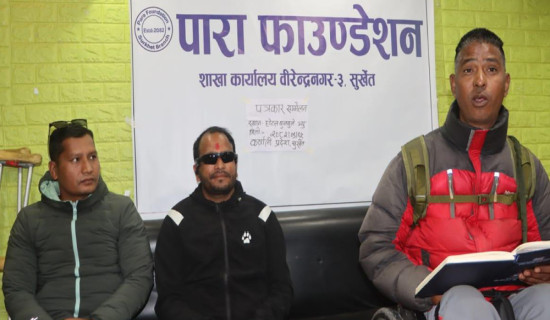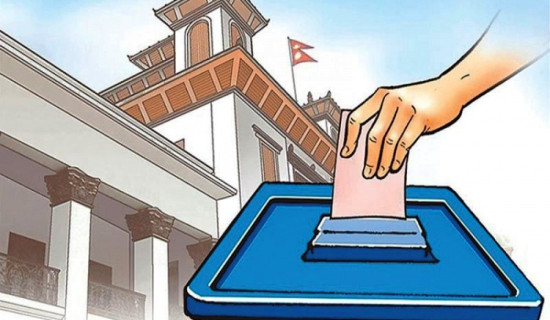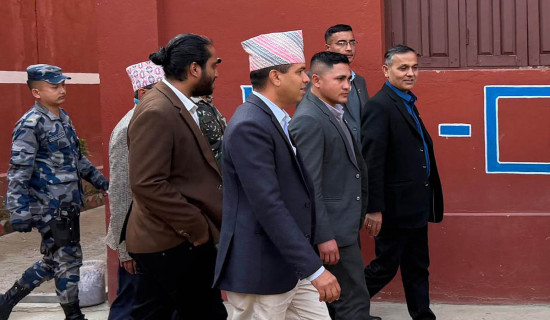- Sunday, 21 December 2025
Need To Enhance Disaster Response Capacity
In the early hours of 28 September 2024, Kathmandu was struck by a devastating flood that left the city reeling. With 300 ml, the highest rainfall recorded in a single day (Kavre), the deluge claimed the lives of 98 people in the Kathmandu Valley alone. And yet, this wasn't even a record rainfall — official data reveals we've seen heavier downpours in the past. How vulnerable are we, even in the heart of the country?
On the morning of 28 September, a large landslide occurred in the Jhyaple Khola in Dhading. Many passengers lost their lives when the landslide buried the buses. Similarly, the flood of the Roshi River in Sindhupalchok also caused great damage, and the passengers were stuck on highways. A lack of trained manpower and necessary materials for rescue was visible. However, the security agencies continued the risky rescue operation as long as the means and resources were available.
Even before that on 12 July, two buses plunged into the Trishuli River at Simaltal, Chitwan, claiming dozens of lives and testing Nepal’s disaster response capacity. Within hours, trained members of Nepal's Armed Police Force (APF), along with more than 200 personnel deployed in rescue operations, arrived at the scene and started their work. The government sought international assistance, which led to the deployment of 12 personnel equipped with advanced technology like sonar systems and magnets for search operations—tools that Nepal lacked. Despite frequent natural disasters — earthquakes, floods, landslides, and more — the country has yet to establish a comprehensive, well-resourced, and functional system for disaster preparedness and response, not just a lame institution.
Lessons learned
Monsoon disaster patterns remind us of the need to shift our focus from reactive measures to proactive disaster management. Concerned government officials can do more than follow a damage-control strategy. If we scan the current disaster response regime in Nepal, at least seven key actions are crucial to correct our past mistakes and build a resilient system. It is important to utilise prior information effectively and promptly. Relevant agencies should provide instructions to their subordinates accordingly. It was observed that despite receiving prior information, there was inadequate preparations. Experts recommended law enforcement to prevent significant consequences. For instance, if the operation of vehicles on the highway had been halted, major damage could be avoided.
The government should normally call an emergency meeting within 2 hours of issuing a red alert by the Department of Hydrology and Meteorology. But the government failed to adhere to this protocol, resulting in a lack of coordination among relevant agencies. On July 6, several villages in Bagmati and Lumbi provinces were flooded due to heavy rainfall the day before. In Sudurpaschim, Kanchanpur recorded 624 mm of rainfall in 24 hours, which is considered extremely heavy. Despite warnings issued two days in advance based on weather forecasts, the National Disaster Risk Reduction and Management Authority (NDRRMA) was not quick enough to act. The same incident happened during the flood of September 28.
Lack of effective early warning system has exacerbated the impact of disasters in several such cases, including the Bhotekoshi floods in 2016 and the recent Thame floods in Solukhumbu. Nepal needs a comprehensive, tech-enabled early warning system that can provide real-time data on natural hazards like floods and landslides. Strict enforcement of the Disaster Risk Reduction and Management Act of 2074 has ensured that emergency centers at all local levels are equipped with manpower and necessary resources. If this provision had been fully implemented, the extent of damage could have been minimised. These incidents have also emphasised the importance of stakeholder coordination and the full implementation of the Disaster Risk Reduction and Management Act 2074.
Responsible leaders can do more than just enjoy the momentary heroism of jumping into "action" to witness the disaster at the site with their security paraphernalia, just getting wet in the flood and taking a few selfies with the victims, or even addressing one workshop after another for response planning in star hotels. Instead, the Ministry of Home Affairs must invest in modern equipment and technology for disaster risk reduction measures. The study suggests that if we invest 1 USD in preparedness, we can save 7 USD in post-disaster management.
The Ministry should invest in empowering and equipping national forces and local governments. Nepal has competent agencies such as the Armed Police Force (APF) and the Nepal Army. These agencies must be provided with continuous training, improved infrastructure, and authorised to act autonomously in times of disaster. The local governments need to be integrated into the national disaster preparedness framework, enabling them to take a lead in disaster-prone areas.
The incident in Simaltal showcased the bravery and dedication of the APF divers, but it also revealed the challenges of operating without advanced equipment. The tools provided by foreign rescue divers, like sonar systems for underwater detection, are essential for modern disaster response and should not be considered luxuries. Nepal needs to invest in obtaining and maintaining such equipment, and training personnel in its use.
Climate-proofing
It is crucial to prioritise disaster-resilient infrastructure, considering the significant losses experienced with the multi-million-dollar Melamchi project, constructed on ADB loan. Investments in infrastructure, such as flood barriers, earthquake-resistant buildings, and safe roadways in landslide-prone areas, can greatly reduce human and economic losses. Despite Nepal's challenging geography, modern engineering can help mitigate these risks if given priority. For instance, a flood in the Koshi basin could wipe away investments worth over $10 billion in the hydropower sector. Therefore, climate-proofing these investments makes a strong business case.
Finally, Nepal needs to work hard to establish preparedness and response through policy and governance, despite substantive support from international partners. Assistance from citizens or international organisations can be a lifeline in moments of crisis. However, relying on it as the primary solution all the time exposes Nepal's willingness and ability to protect its citizens. While Nepal has made progress in policy making, including the establishment of NDRRMA, implementation often falls short. This also highlights the need for a clear chain of command during emergencies. The shortcomings should be remembered as lesson and a wake-up call.
(The author is a senior journalist who writes on climate change, disasters, gender and development issues.)












-original-thumb.jpg)



